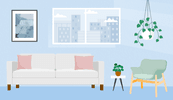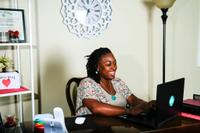Modern Office Design for Therapists

Modern office design can influence our clients’ ability to feel welcome, safe, and comfortable.
Our brains subconsciously use all our senses to process places, environments, and atmospheres, and modern office design can make a significant impact.
For many people seeking health and wellness services, it can be difficult to open up and feel safe in a practitioner’s office.
So, how can you create a space with a modern office design that helps you break down those walls?
As an interior designer, I love creating a modern space for my clients that makes them feel safe, happy, and comfortable—and I’ll show you how to do this in your office space.
The Origins of Modern Office Design
Modern design began in the early 20th century. Modernist architects had a bit of a battle cry: “Form follows function.”
In other words, they argued we should never have anything in a space that doesn’t serve a purpose, and that a clutter-free space is a clutter-free mind.
Some schools of design thought, like Danish modern and mid-century modern designs, consider minimalism to be the backbone of clean and easy living.
These schools believe that if you follow the rules of modern design, you’ll have less trouble maintaining a clutter-free life.
Though these concepts originated in the home design world, their lessons apply well to creating a modern office design that’s warm and welcoming.
As a consequence, your office space will be more conducive to the work you’re doing with clients.
The Keys to Creating a Safe Modern Space
I’ve always believed that first impressions are the most important.
As practitioners, after your website, your office is one of the first impressions you make on a new client.
In my personal experience as a client, I’ve gone into a therapist’s office where the atmosphere was dark and stuffy.
There were no windows anywhere.
When it came time for my session, I found myself having a hard time opening up. All I could think about was how claustrophobic I felt in that space.
Nothing really came out of that session for me, and unfortunately I never went back there.
Clients may not return to your practice for any number of reasons, but a lack of an inviting space shouldn’t be one of them.
When I think of a welcoming office as a designer, I believe the feng shui should be just as inviting as you would make your own home. Bringing in calming colors, the right lighting, and soothing scents and textures can relax your clients and make a big difference in their experience with your practice.
1. Consider the Atmosphere You Want to Create
There’s more to creating a safe space than just modern office design. It’s about curating an atmosphere from the moment your client walks through the door.
For example, if possible, there should be nothing blocking the pathway from the door to the front desk or waiting area.
It’s also best to avoid unnecessary furniture or nicknacks in the waiting area, which can add visual clutter.
At the same time though, you want enough furniture so your space doesn’t feel austere, and remains functional for clients and guests.
Aside from the waiting area, your actual office can easily become distracting if you don’t keep your space clutter-free.
If you can use a digital system for things like billing and client notes, you can not only reduce the paper clutter in your space but simplify how you run your practice.
This is the same method I use to keep my own design work organized, and it’s made my life much easier.
2. Let in the Light
Natural light from windows can have a huge impact on how your clients feel when they first walk into your office. But even if you don’t have that natural light, you can create artificial daylight. LED lighting has a similar look and feel to natural daylight, and has the added bonus of being more energy efficient than other kinds of lightbulbs.
To create the feeling of natural light, even in a room with few or no windows, you can use cove lighting, which is created with LED light strips. The shadows these strips create mimic natural light, and are an inexpensive way to light an entire room. In general, I recommend using lights that aren’t too harsh. To create the “cove” in cove lighting, you can use a peel-and-stick molding, that’s affordable, easy to install, and removable.
If you don’t want to alter your office by installing cove lighting but still want a more homey atmosphere, other sources of lighting with diffusers can have a similar effect. Diffusers soften the light and keep your space looking clean. If you’re able to use a wall sconce that will help keep your table tops and floors clear of clutter, but if that’s not an option, you can look to add a lamp shade diffuser to your lampshades.
3. Don’t Be Afraid of Color
Color can affect your mood and signal an internal reaction.
As therapists, you want to use color in your office to create a sense of calm and stability in your space by bringing in blues, greens, grays, and beiges. Bold and bright colors, like yellow, can increase anxiety and raise blood pressure, and red has been known to bring out feelings of anger.
However, the key to choosing from these blue and green color families is to not choose colors that are too cold. Cooler blues and grays can elicit feelings of sadness in clients, so choosing colors with warmer undertones will help you strike that balance. Warm blue tones can bring feelings of serenity, peace, and security. It’s also known to produce productivity in people who work in a blue room. Green reminds us of being in nature, so even bringing a soft, light green color can really lift some spirits.
Even if you’re not able to paint your office space, adding some color will keep your office from looking too sterile.
Peel-and-stick wallpaper is one way to bring in these colors in a way that’s, again, affordable and removable. You can also use your furniture, accessories like pillows, and artwork to bring them in as well.
4. Include Softness and Texture
While visuals have a huge impact on how people experience your space, touch is also extremely important to how we process our environment.
Having soft fabrics and plush fabrics on your furniture can help them feel more comfortable and focused on why they’re there to see you. A chair like this one might be good for a waiting room or a group session, while this one would work for individual sessions, where clients might feel more at ease and ready to get comfortable.
5. Bring in Natural Elements
Nature is extremely soothing to people, and bringing in small natural elements can make your space feel more refreshing and comfortable. A small water feature with light sounds of water flowing can help clients feel peaceful and serene, while also not requiring much more of your office than an electrical outlet.
Natural green plants can also help your space feel fresh and clean.
A personal favorite of mine is a Chinese money plant, because it has such a beautiful and vibrant color. It fits perfectly on a side table or a shelf, and brings a lot of life to a space without being too overwhelming. It’s also very low-maintenance to care for.
These are just some of the ways you can introduce a warm and welcoming atmosphere into your space.
As every practitioner’s office situation is different, the exact ways you set up your space will also differ.
However, if you follow these guidelines for creating a modern office design, it’ll help your clients feel like you’re focused on their overall well-being, and that they’re in good hands.
How SimplePractice Streamlines Running Your Practice
SimplePractice is HIPAA-compliant practice management software with booking, billing, and everything you need built into the platform.
If you’ve been considering switching to an EHR system, SimplePractice empowers you to run a fully paperless practice—so you get more time for the things that matter most to you.
Try SimplePractice free for 30 days. No credit card required.
READ NEXT: Top Therapist Office Design Tips
More Stories
Stay inspired
Get the latest stories from your peers right to your inbox.










